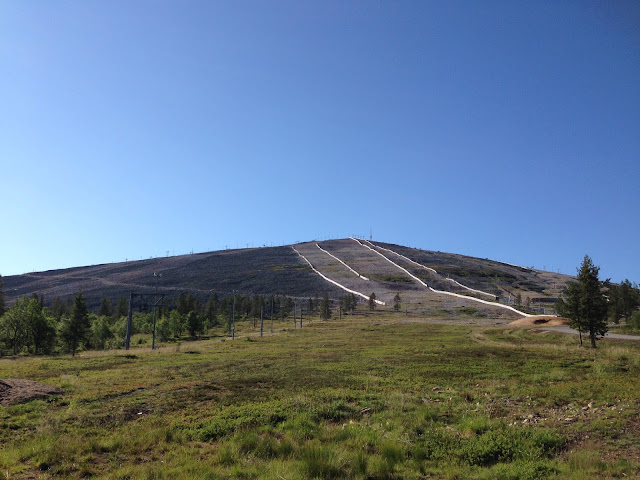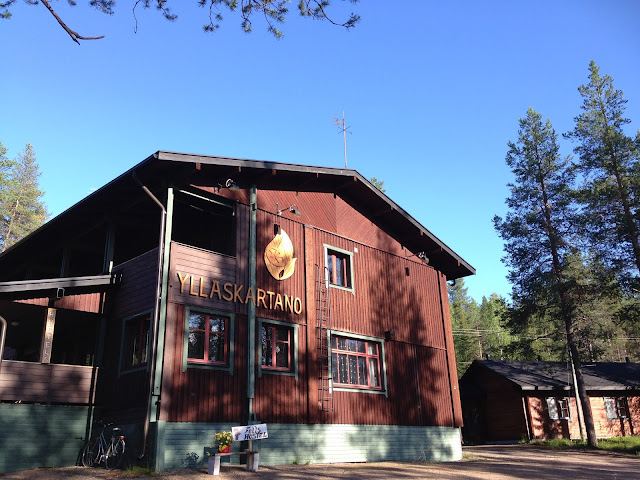Our last stop in Finnish Lapland_ Äkäslompolo, route E8 to Tornio (before driving back to Rovaniemi). The part of the E8 we drove (except when we leave it in Muonio to go to Äkäslompolo) runs from Tromso (Norway), passing through the border with Norway in Kilpisjärvi (Finland) always along the border with Sweden, which is almost all the beside the river Muonionjöki until Tornio (where it joins the E75 to Helsinki). _Última etapa a la Lapònia finlandesa_ Äkäslompolo i la E8 fins a Tornio (abans de tornar a Rovaniemi). El tros de E8 que vam agafar (excepte quan ens vam desviar a Muonio per anar cap a Äkäslompolo) discorre des de Tromso (Noruega), passa per la frontera amb Noruega, a Kilpisjärvi (Finlàndia), sempre al costat de la frontera amb Suècia, divisant, pràcticament tota l'estona, el riu Muonionjöki, fins a Tornio (on enllaça amb la E75 fins a Hèlsinki).

Äkäslompolo is a village in the municipality of Kolari in Lapland. It had 437 inhabitants at the end of 2011. Äkäslompolo is located around the lake of the same name in the Pallas-Yllästunturi National Park (the third largest in Finland). _Äkäslompolo és un poble de la municipalitat de Kolari, a la Lapònia. Tenia 437 habitants a finals de 2011. Äkäslompolo es troba al voltant del llac del
mateix nom, dins del Parc Nacional Pallas-Yllästunturi (el tercer més gran de Finlàndia).




The blue building that you see in these images is the church of Äkäslompolo, which contrasts with the traditional red painted wood architecture. _L'edifici blau que veieu en una d'aquestes imatges, és l'església d'Äkäslompolo, que contrasta amb l'arquitectura més tradicional de fusta vermella.

Its main source of income is tourism in Ylläs, ski area (which it shares with the neighboring town of Ylläsjärvi) during the winter season and, more recently, Ylläs Soikoon music festival, which attracts a new tourism in the summer. _La seva principal fonts d'ingressos és el turisme a Ylläs, les pistes d'esquí (que comparteix amb la població veïna d'Ylläsjärvi) durant la temporada d'hivern i, més recentment, el festival de música Ylläs Soikoon, que atrau, juntament amb l'excursionisme, un nou turisme a l'estiu.

Äkäslompolo is also known as "the town of the seven hills": Yllästunturi, Kuertunturi, Kukastunturi, Pyhätunturi, Kesänki, Lainiotunturi and Kellostapuli. The Ylläs ski area has a total of 330 km of cross-country ski tracks, and 61 Alpine ski slopes with 29 ski lifts. Yllästunturi has two ski centers: Äkäslompolo Ylläs-Ski and Sport Resort Ylläs. Together they form the largest ski area in Finland. In addition, there are around 410 km of routes for snowmobiles. _Äkäslompolo és també conegut com "el poble dels set turons": Yllästunturi, Kuertunturi, Kukastunturi, Pyhätunturi, Kesänki, Lainiotunturi ja Kellostapuli. Aquí hi discorre la xarxa més extensa de senders de Finlàndia, que compta amb un total de 330 quilòmetres de pistes d'esquí de fons, dels quals 38 quilòmetres s'il·luminen, i 61 pistes d'esquí alpí amb 29 remuntadors. Yllästunturi són dos centres d'esquí: Äkäslompolo Ylläs-esquí i Sport Resort Ylläs. Junts formen la zona més gran d'esquí de Finlàndia. A més, al voltant hi ha uns 410 km de pistes per a motos de neu.



In summer Äkäslompolo is popular among hikers, anglers, canoeists, and other outdoor enthusiasts. Buildings are widely dispersed from each other, what frees the nature of the stress from overcrowding. _A l'estiu, com dèiem, Äkäslompolo és popular entre els excursionistes, pescadors, piragüistes i altres amants de l'aire lliure. Les edificacions estan molt disperses les unes de les altres, això allibera la natura de la tensió de la massificació.


There are several hotels and many holiday homes and cabins (mökki) in the area. For example, the Seven Fells Hostel, where we stayed there one night. Apart from the rooms of the main building, if you have the opportunity to stay in one of their cabins, you will surely live a "lodge" experience surrounded by a summer green and vibrant nature, and the show of the snow and northern lights in winter. _Hi ha diversos establiments per a l'allotjament i moltes cabanes (mökki) en lloguer a la zona. Com per exemple, el Seven Fells Hostel, en el que ens hi vam allotjar una nit. A part de les habitacions de l'edifici principal, si teniu la possibilitat d'allotjar-vos en alguna de les seves cabanes, viureu, de en segur, una experiència lodge envoltat de natura verda i vibrant a l'estiu, i de l'espectacle de la neu i les aurores boreals a l'hivern.



Surely you'll see reindeers and squirrels from your window! _De ben segur que, en qualsevol moment, podreu veure rens o esquirols des de la vostra finestra!


Next day we continued the route... to Tornio, on the border with Sweden, before driving back to Rovaniemi. _L'endemà vam continuar la ruta... fins a Tornio, a la frontera amb Suècia, abans de recular cap a Rovaniemi.






Until the late nineteenth century, the inhabitants of nearby spoke Finnish and Sami Kemi, while the city itself dominated the Swedish language. After World War II was installed at Tornio popular brewery Lapin Kulta ('the gold of Lapland'). A large shopping center is the new frontier, and from Finland, an IKEA awaits on the other side. _Fins al final del segle XIX, els habitants dels voltants parlaven finès i
sami de Kemi, mentre que a la ciutat mateixa predominava l'idioma suec. Després de la Segona Guerra Mundial a Tornio s'hi va instal·lar la popular
fàbrica de cerveses Lapin Kulta (literalment: l'or de Lapònia). Un gran centre comercial n'és la nova frontera i, des de Finlàndia, un IKEA t'espera a l'altra banda.



Nauttikaa! Enjoy_gaudiu!
MOI, MOI! Ja ihanaa viikonloppua!



The city was founded on the island of Suensaari (1621). The name of Tornio is an old Finnish word meaning spear: the city is named for the river Tornio. During the eighteenth century was visited by several expeditions going to the Arctic. The most notable was that of a member of the Académie Française, Pierre Louis Maupertuis, who was measuring the meridian arc. The top of the church of Tornio was one of the points used for Maupertuis in his measurements. This church was built in 1686 by Matti Härmä Joosepinpoika. Tornio church is one of oldest and most well-preserved wooden churches in the Northern Finland and Scandinavia. _La ciutat va ser fundada a l'illa de Suensaari (1621). El nom de Tornio és una paraula de l'antic finès i significa llança de guerra: la ciutat rep aquest nom pel riu Tornio. Durant el segle XVIII va ser visitada per diverses expedicions cap
l'Àrtic. La més notable va ser la d'un membre de l'Académie Française,
Pierre Louis Moreau de Maupertuis, qui hi va mesurar l'arc de meridià.
La part de dalt de l'església de Tornio va ser un dels punts usats per
de Maupertuis en els seus mesuraments. Aquesta església va ser
construïda el 1686 per Matti Joosepinpoika Härmä. L'església de Tornio és una de les esglésies de fusta més antigues i ben conservades al nord de Finlàndia, i de tots els països nòrdics.





Tornio and Haparanda (the Swedish zone) are twin cities, and historically there is a project to merge under the name TornioHaparanda and HaparandaTornio. _Tornio i Haparanda (la part sueca) són històricament ciutats bessones i hi ha el
projecte de fusionar-se sota el nom de TornioHaparanda i
HaparandaTornio.

Nauttikaa! Enjoy_gaudiu!
MOI, MOI! Ja ihanaa viikonloppua!
Cap comentari:
Publica un comentari a l'entrada